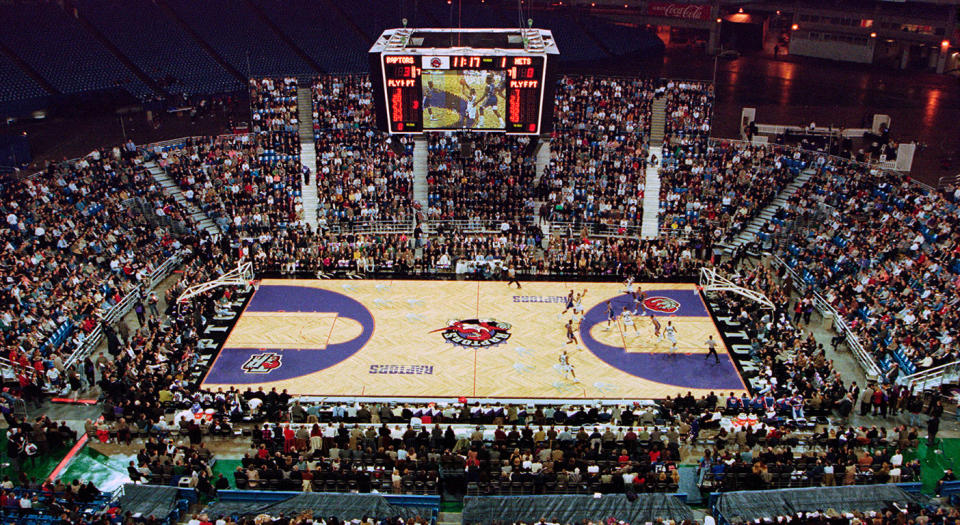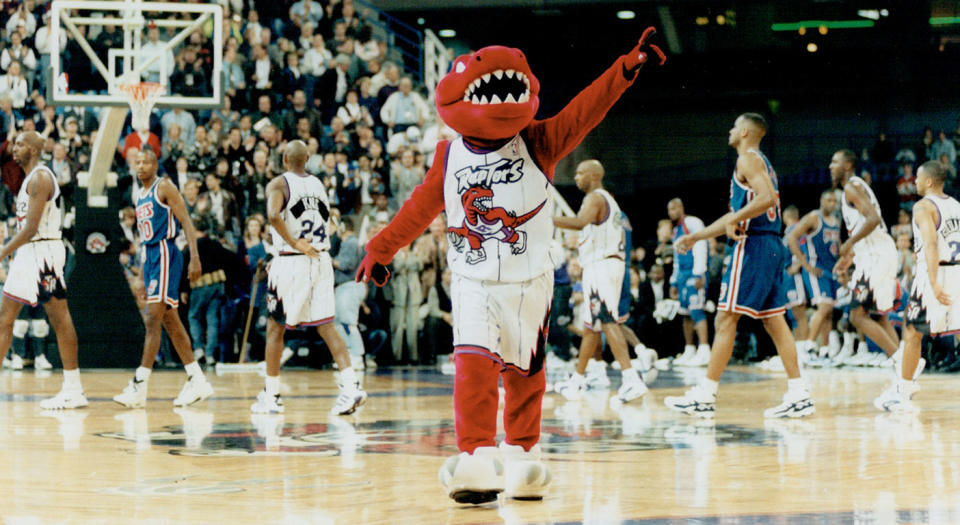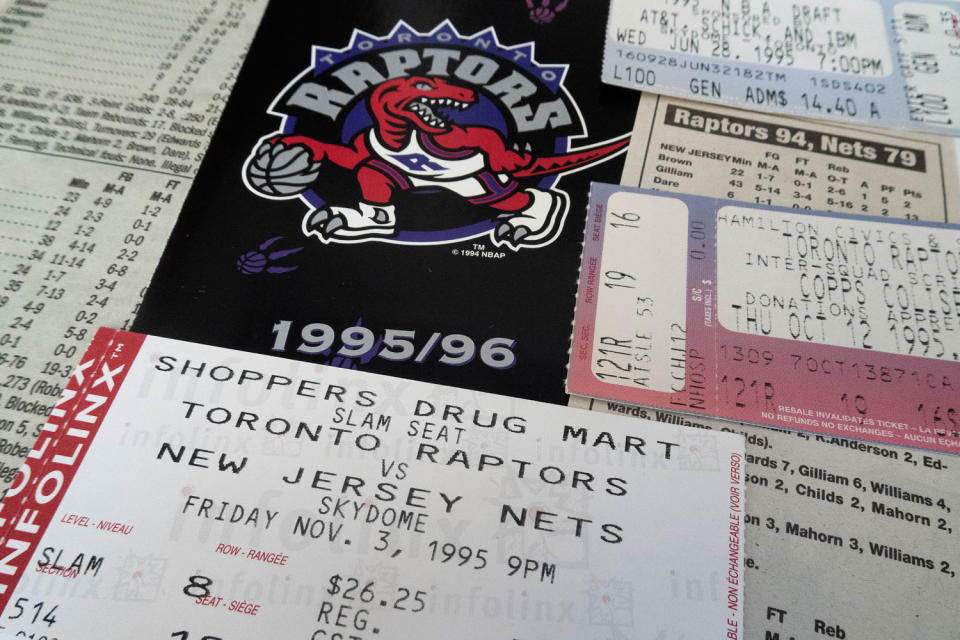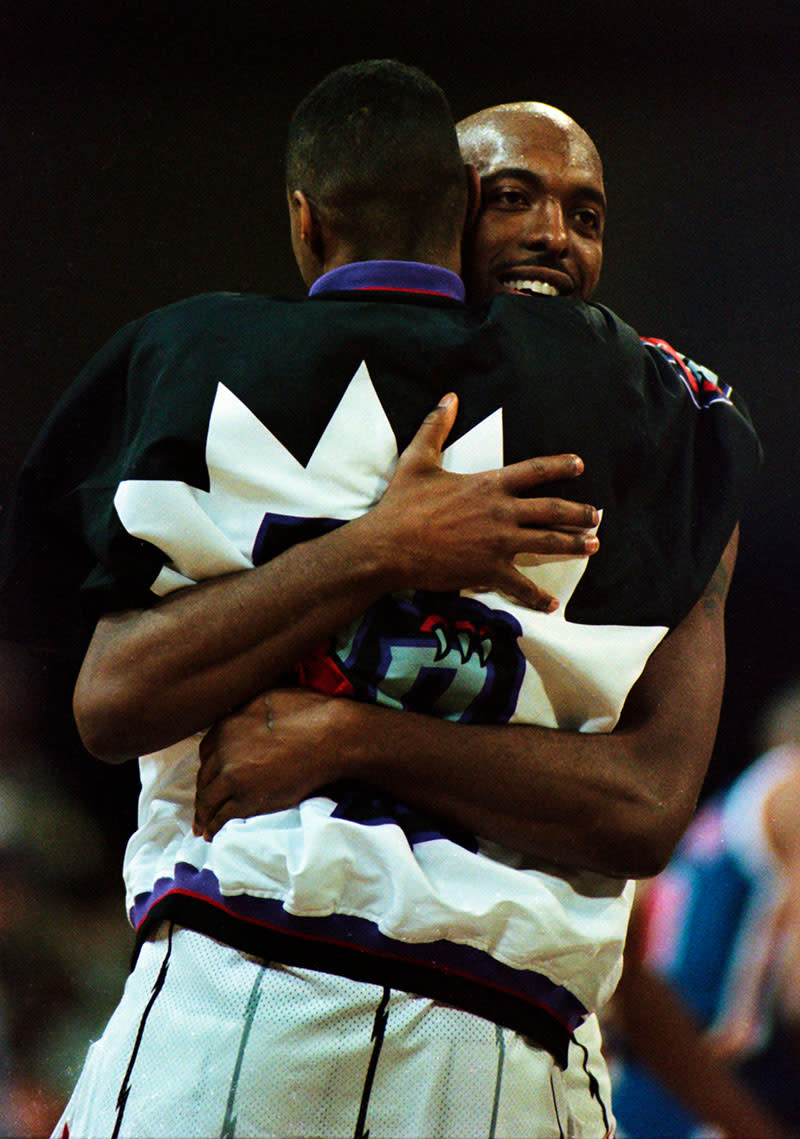The Raptors have come a long way since their very first game

On Wednesday, the Toronto Raptors will host their first Christmas Day home game in franchise history as defending champions against the Boston Celtics.
It still feels improbable to say those words about the Raptors, once the laughingstock of the league and a franchise that seemed destined to linger in mediocrity for eternity.
A lot has changed since the beginning. The Raptors have come so far they brought back the original dino jerseys this season and can comfortably celebrate the entire history of the franchise — the good, the bad, and the ugly.
As the Raptors hit another milestone for their franchise, here’s a look back at the very first regular season game for the franchise, and what those who were around the team remember about the early days:
Entertainment first, basketball second
The history of the Toronto Raptors started in a baseball stadium. On Friday, Nov. 3, 1995, the franchise played its first ever regular season game at the SkyDome, hosting the New Jersey Nets.
Their starting lineup featured the franchise’s first draft pick, Damon Stoudamire, along with four players who were cast off and acquired either in the expansion draft or via free agency and trade: Zan Tabak, Ed Pinckney, Carlos Rogers and Alvin Robertson.
Brian Cooper, the team’s vice president of business development and operations, was in attendance for opening night. He had spent the months leading up to this game traveling to different NBA arenas across the United States, analyzing each team’s music sets and in-game video content.
Promoting a new sport in Canada was a challenge in itself and Cooper knew it would be much harder trying to promote a team that wasn’t going to win too many games.
“We had to have a level of quality with the entertainment,” Cooper says. “Because I knew the level of quality of basketball wasn’t going to be there.”
Nothing was off limits. Sister D, a boxing nun, would appear on the Jumbotron regularly during Raptors games, prompting fans to chant defence. Cooper is proud of inventing 60 Seconds of Madness, where the Dance Pak would throw t-shirts into the stands during a timeout break.

There was an experimental aspect to it all. Cooper remembers taking Oliver Miller’s jockstrap and his size 22 shoes and throwing them into the stands as an impromptu giveaway towards the end of the first season.
There was also no shortage of celebrities in attendance sitting among the sold out crowd of 33,306 on opening night. The names included David Hasselholf, Kathy Ireland, Kurt Browning and Paul Molitor. Throughout the inaugural season, Samuel L. Jackson, Meat Loaf and Prince were among the other star names who dropped in at the SkyDome.
During the season, Cooper would contact the Toronto Film Association. If there were any television and movie stars in town, he would invite them to sit front row. It was all part of a strategy to make going to a Raptors game a local spectacle. The Blue Jays were coming off back-to-back World Series wins in 1992 and 1993. The Leafs remained the most popular ticket in town. Cooper needed to do anything to drum up interest about the Raptors.
Opening night would be a chance to set the tone.
Before tip-off, the Raptor mascot came out of a dinosaur egg at center court, unofficially signifying the birth of the franchise. Jeffrey Naismith — great, great grandson of James Naismith — was on hand for the ceremonial tip-off. The Barenaked Ladies sang the national anthems (Aretha Franklin was originally booked, but later dropped out. Brandy and The Temptations were also considered).
At halftime, Cooper walked the concourse of the SkyDome. The positive feedback he overheard from fans was enough validation for the first night.
“I felt so relieved,” Cooper says. “We were not great, but we were also not bad. We didn’t suck, and we were going to get better. I remember John [Bitove Jr.] gave me a high-five and a hug and said, ‘Let’s keep it going.’”
“We could sell $5 tickets in the 500 level and get people into a basketball game”
Leo Rautins was the colour commentator for the very game and is still calling Raptors games today. During the early years, he came to enjoy his pre-game routine at the SkyDome, which included having breakfast at the hotel connected to the stadium, allowing Rautins to enjoy his meal while watching both teams go through shootaround.
Not everyone enjoyed the SkyDome as much as Rautins, though.
Tracy Murray was a member of the 1995-96 Raptors. “It was always cold in there,” Murray says. “You had to get there early and really get your body warmed up.”
Rautins says some players found playing in a dome to be a challenge.
“They would find there was an adjustment shooting with that backdrop,” Rautins says. “A lot of guys who weren’t necessarily great shooters could be bothered by it.”
Bitove says the ability to fill more people into a stadium was an advantage. “In some ways, those early years were great,” Bitove says. “We could sell $5 tickets in the 500 level and get people into a basketball game who couldn’t afford to go otherwise. It was a blessing in disguise.”

Darryl Defranco was one of the 33,306 fans in attendance for the inaugural game. His seats were so far from the court he would watch most of the game on the Jumbotron. But it didn’t matter.
“I didn’t care where I sat,” Defranco says. “I just wanted to be in the building. The [SkyDome] wasn’t ideal for watching basketball, but it was like, Toronto has a basketball team now and it was the best thing ever.”
“It was a fine line of teaching and not alienating”
Robertson scored on Toronto’s first possession on opening night, going into the record books with a 3-pointer. The Raptors raced out to a double-digit lead in the second quarter, when the first illegal defence violation of the game was called.
On the broadcast, Rautins walked the viewers through the definition of illegal defence. It would be a running theme throughout the first season. The broadcast needed to educate a lot of the audience who had not watched basketball regularly.
“It was a fine line of teaching and not alienating,” Rautins says. “We couldn’t talk down to the audience, but we also couldn’t go over the audience’s heads either. Sometimes you pissed off the hardcore fans. Other times the novices didn’t know what you were talking about.”
Bitove would videotape the games in order to study the broadcasts for ways to improve. One of the early criticisms he had for the producers of the games was that they were slow to update the score on the television screen.
“I had a meeting with the broadcast guys to let them know this wasn’t hockey,” Bitove says. “When the team scores, you don’t have 30 seconds to change the score. The next basket is going to be scored in like the next 15 seconds. You’re going to lose track of the score. Those were things we had to work on.”
On opening night, the in-game arena team accidentally handed out noisemakers in the second half to fans sitting behind the basket where the Raptors were shooting, unaware that teams switched sides at halftime. So, when the Raptors shot free throws in the second half, it felt like they were on the road, being distracted by fans as they shot. Bitove remembers sitting beside NBA commissioner David Stern as it unfolded.
“He elbowed me,” Bitove says. “And he said, ‘John, are you trying to teach us something new?’”
The first win

It was no coincidence the Raptors played the Nets for their very first game. The Nets had won just 30 games the year prior, and Bitove specifically lobbied the NBA to schedule them for opening night.
“We wanted that win,” Bitove says. “And let’s just say the Nets weren’t one of the better franchises back in the day.”
Almost 25 years later, there are plenty of easter eggs embedded in the Raptors’ first ever game. The Nets’ starting point guard that evening was Kenny Anderson, who in just a few seasons would be traded to Toronto for Stoudamire. Anderson never played for the Raptors, refusing to report to Toronto after the trade and was re-routed to the Boston Celtics.
Another moment that made me shake my head: in the third quarter of the broadcast, Rautins referenced the 17-65 Los Angeles Clippers from the previous season as a potential benchmark for the expansion Raptors. Nobody could have guessed at the time the two franchises would eventually be forever linked thanks to Kawhi Leonard.
The subplot everyone focused on that evening, though, was between Stoudamire and Ed O’Bannon.
Just a few months earlier, the two were at the SkyDome for the 1995 NBA Draft. Raptors fans showered Stoudamire with boos when he was selected seventh overall. The fans wanted O’Bannon— the USBWA College Player of the Year and NCAA Final Four Most Outstanding Player who had led UCLA to an NCAA championship — who would later be taken by the Nets with the ninth overall pick.
Stoudamire outplayed O’Bannon that evening, scoring 10 points and adding 10 assists and three steals. Stoudamire would go on to win Rookie of the Year. O’Bannon scored four points in 16 minutes on opening night, and played just 128 games in his NBA career.
The Raptors had made the right choice, for many reasons.
“I really thought he was a great pick for an expansion franchise,” Rautins says. “If you had a 7-footer swinging off the rim, how many guys watching the game can identify with that player? Damon was an average size dude, kids could say, ‘I can play in the NBA. Look at that guy.’”
“It was as much a celebration as it was the beginning of something”
With 20 seconds left in the fourth quarter, the crowd rose to their feet to serenade the Raptors with their first standing ovation, as Stoudamire went to the free throw line to put the game away. The Raptors defeated the Nets on opening night 94-79. They would lose their next seven games and not win again for two weeks and only win 21 games in their first season, but it didn’t matter that evening.
Bitove still has the game ball from that night, and has fond memories of the very first game.
“It was as much a celebration as it was the beginning of something,” Bitove says.
Rod Black, who provided play-by-play of the game for CTV, remembers having goosebumps at the SkyDome. He still remembers all of the flash bulbs going off at tip-off.
“You don’t see that anymore,” Black says. “There was no Twitter or Instagram. Very few people had cell phones.”
The Canadian broadcaster also remembers wondering if this would all work.
“I remember the excitement level,” Black says. “But I also remember the trepidation and hesitation from some people that this might not last. I sat there with my own skepticism and wondered if this was really going to work. You just didn’t know.”
Murray also remembers whether anyone would care about a basketball team in Toronto when he first arrived. In one of his first public appearances, he travelled a few hours outside of Toronto to a Sears with the Raptor mascot and six Dance Pak members.
“Six people showed up to our appearance,” Murray says. “We signed a couple of autographs, took some photos, got back in the van and just laughed about it.”
Twenty four years later, the Raptors are NBA champions.
They’ve come a long way from their very first game.
More Raptors coverage from Yahoo Sports


